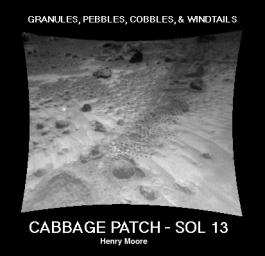This Sojourner rover image of the "Cabbage Patch" shows small rounded objects on the surface that are about 3-4 cm across. Some of these are within excavations, which are about 0.5 cm wide. Several questions arise about the pebbles: Why are they rounded? Where did they come from? What do they mean?
Geologists use MULTIPLE WORKING HYPOTHESES when attempting to explain observations. Some hypotheses that could account for the pebbles are:
- They were rounded during transport by waters of catastrophic floods and deposited on the Ares Vallis floodplain
- They were rounded by wave action on an ancient Martian beach
- They were rounded during glacial transport
- They are glasses that were produced by melting during impact cratering. The glass was first ejected from the crater, then molded into spherical shapes or drops as it traveled through the atmosphere, and finally was deposited at the sites
- They are spatter from lava flows
- They are nodules brought up from the deep Martian interior by lava flows or pyroclastic eruptions.
- They are concretions formed in sedimentary rocks
- They came from ancient conglomerate rocks. The pebbles were rounded by water action and subsequently lithified into conglomerate rocks. Later, the waters of catastrophic floods transported the conglomerates and deposited them on the Ares floodplain. The pebbles were then freed from the rocks by weathering.
- A combination of the above
Mars Pathfinder is the second in NASA's Discovery program of low-cost spacecraft with highly focused science goals. The Jet Propulsion Laboratory, Pasadena, CA, developed and manages the Mars Pathfinder mission for NASA's Office of Space Science, Washington, D.C. JPL is a division of the California Institute of Technology (Caltech).
Photojournal note: Sojourner spent 83 days of a planned seven-day mission exploring the Martian terrain, acquiring images, and taking chemical, atmospheric and other measurements. The final data transmission received from Pathfinder was at 10:23 UTC on September 27, 1997. Although mission managers tried to restore full communications during the following five months, the successful mission was terminated on March 10, 1998.

 Planetary Data System
Planetary Data System












